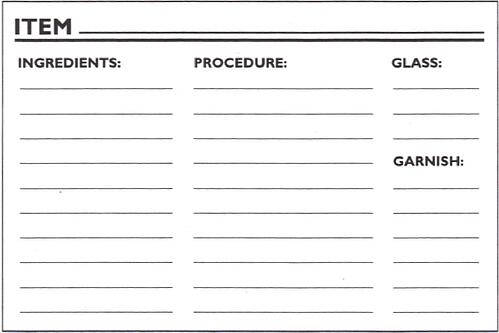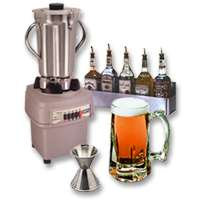By Bob Johnson
Part 1 of 2: Do Bartenders Steal?
 Do bartenders steal? I've worked with some outstanding bartenders over the years, men and women who are honest, hard-working, team/family-oriented and loyal. I'd like to think all bartenders are like that, but according to some, I'm misguided.
Do bartenders steal? I've worked with some outstanding bartenders over the years, men and women who are honest, hard-working, team/family-oriented and loyal. I'd like to think all bartenders are like that, but according to some, I'm misguided.
Joe Motzi of Entrepreneur Consultants in New York wrote an article on the subject for Restaurant Hospitality magazine, in which he said: "The theft is incredible! In the past three years we ran across only one bartender who wasn't stealing from his employer. That's out of about 1,000 clients! Only one bartender went by the rules of the house!"
Employee Service Reports in Fort Myers, Florida, a surveillance service to restaurants and lounges since 1950, reports that more than 50 percent of bartenders surveyed are not recording sales. That's a polite word for stealing. After weeding out the undesirable employees, the theft problem goes away - at least until after the new hires are comfortable with taking advantage of management.
A Michigan bar owner I know fired her last nine bartenders for stealing - in just one year. The owner of the Au Main bar in New York City has filed a $5 million lawsuit against 12 former bartenders and his chief financial officer for "working together (collusion) against the house, not recording drink sales and splitting the money amongst them for the past 8 years". The CFO changed the numbers in the books to cover up the missing inventory.
The temptation for a bartender to steal, and the ease of doing it, is scary. Receiving cash each time you sell a drink creates the temptation to keep the money (is anyone watching?). The drink sale is simply not rung up. The money for the drink goes straight into the cash register drawer by hitting "00" (No Sale), or they work out of an open drawer. They keep track of how much they are "over" by using a type of abacus system - 3 match sticks in a nearby empty glass equals $30, or a black sneaker mark on the floor equals $20 (3 black marks and they're up about $60).
The bartender takes the "over" out of the cash register drawer before turning in their money. Selling a cup of coffee or a "virgin" daiquiri (non-alcoholic) increases the temptation for bartenders or servers to take that money, too. Most bars do not inventory non-alcoholic type drinks, and most do not require their bartenders/servers to issue a receipt for each sale.

While taking from you, there's a good chance they're also cheating your customers. Your bar might feature "tooters", which are 24 shots of liquor served in a one-ounce tube. The bartender is supposed to sell them for a buck apiece, but decides to charge the customer $2 - and pockets $24 at the customer's expense. Of course, the house gets hurt when the customer discovers the scam.
The theft process starts when first hired. The bad bartender usually looks for areas where management is lax. They run little "spot tests" - seeing what will work and what won't. Once it's established what works it's full steam ahead.
Another type is the overt thief - one who steals openly, thinking no one, including the customer, realizes what he or she is doing. Professional spotters describe this type of bartender theft as "wide open". These people fear no one - customer or management.
This is reason enough to use professional surveillance companies, or spotters, routinely. Spotters are hired to watch for, and report, any act of theft by a bartender, waitress, manager, or any employee working on the premises.
However, there can be problems with spotters. Many don't understand a bartender's organization, motion, or actual transactions. Many are also "minimum wage plus expenses" employees of a local security company and have never tended a bar before. The best spotter is one who has bar experience and can detect a discrepancy in another bartender's work routines.
Bob Johnson is a nationally recognized Beverage Management consultant who specializes in multi-unit management of nightclubs/bars and bartending. He is a 50 year veteran of the bar business and is known for creating America’s first certification program for bar managers, “CBM” (Certified Bar Manager). Mr. Johnson has taught at Florida International University in Miami, Florida, serving as Professor of Beverage Management.
Mr. Johnson can be contacted at:
Website: BobTheBarGuy.com
Email: bjbarhop@aol.com

 Industry studies have consistently shown that a full 25% to 30% of a bar's liquor inventory never converts into registered sales. That is the equivalent of about six to eight 1.25 oz portions per bottle (which should yield at least 25 portions.) This loss of liquor volume--due to unauthorized comps, over-pouring, spillage or theft--should be of great concern to any bar manager.
Industry studies have consistently shown that a full 25% to 30% of a bar's liquor inventory never converts into registered sales. That is the equivalent of about six to eight 1.25 oz portions per bottle (which should yield at least 25 portions.) This loss of liquor volume--due to unauthorized comps, over-pouring, spillage or theft--should be of great concern to any bar manager.  A typical beverage operation generates a constant stream of data and information, endless columns of figures and daily records. But you'd be surprised how few managers actually do anything with these figures, let alone fully grasp their implications. So how can you tell if you're operating profitably? The answer is you can't, unless, of course, you get to grips with some basic mathematics. For a start, you'll need to know how to perform a few simple calculations, such as working out an item's cost percentage. You don't need to be a mathematician to figure the following straightforward formulas:
A typical beverage operation generates a constant stream of data and information, endless columns of figures and daily records. But you'd be surprised how few managers actually do anything with these figures, let alone fully grasp their implications. So how can you tell if you're operating profitably? The answer is you can't, unless, of course, you get to grips with some basic mathematics. For a start, you'll need to know how to perform a few simple calculations, such as working out an item's cost percentage. You don't need to be a mathematician to figure the following straightforward formulas: Making a good mixed drink isn't always a matter of A + B = C. In fact, there are numerous small details that can contribute to turning your creation into something just that little bit better than the norm and, more still, that can help you keep your ingredients at peak freshness and productivity. Consider the following:
Making a good mixed drink isn't always a matter of A + B = C. In fact, there are numerous small details that can contribute to turning your creation into something just that little bit better than the norm and, more still, that can help you keep your ingredients at peak freshness and productivity. Consider the following: The difference between a good and great martini is very small, but very important. The quality of your cocktail menu should be of paramount importance to you. The methods by which those cocktails are prepared should be a point of pride for all concerned.
The difference between a good and great martini is very small, but very important. The quality of your cocktail menu should be of paramount importance to you. The methods by which those cocktails are prepared should be a point of pride for all concerned. Herb-infused spirits. Whether they be whiskies, vodkas or gins are gaining herb-infused drinks are gaining in popularity. Expect gin, especially, to continue to make a splash as both large producers such as Bombay and a slew of new micro distilleries continue infuse this old stalwart with fresh and interesting botanicals.
Herb-infused spirits. Whether they be whiskies, vodkas or gins are gaining herb-infused drinks are gaining in popularity. Expect gin, especially, to continue to make a splash as both large producers such as Bombay and a slew of new micro distilleries continue infuse this old stalwart with fresh and interesting botanicals. Seasonal and flavored beers. While nothing new, seasonal and/or flavored beers are starting to gain traction.
Seasonal and flavored beers. While nothing new, seasonal and/or flavored beers are starting to gain traction. Value. After several years of economic recession, consumers have acquired a taste for value wines. They are seeking bang for the buck—not cheap inferior wines, but good, well-balanced, flavorful wines at an affordable price. With many of these wines coming from Spain and South America, expect Spanish, Chilean and Argentinian wines to continue to grow in popularity.
Value. After several years of economic recession, consumers have acquired a taste for value wines. They are seeking bang for the buck—not cheap inferior wines, but good, well-balanced, flavorful wines at an affordable price. With many of these wines coming from Spain and South America, expect Spanish, Chilean and Argentinian wines to continue to grow in popularity.
 When you design your service area, it's important to realize that every step a bartender takes in the serving of a drink is costing you money and making your customers impatient. Where does your staff need to walk to get a clean glass? How far from there to the ice bins and then to the spirit dispenser? And where are your soda guns in relation to the bottles? Is the cash register yet another trip away from the customer? Even if your bartender has to take only four or five steps between each of these posts, consider how far that means your bartender has to walk in the course of serving 500 drinks a night! This is bad enough for a solo bartender, but when two or three people are working behind the same bar and sharing facilities, it can be an unproductive nightmare.
When you design your service area, it's important to realize that every step a bartender takes in the serving of a drink is costing you money and making your customers impatient. Where does your staff need to walk to get a clean glass? How far from there to the ice bins and then to the spirit dispenser? And where are your soda guns in relation to the bottles? Is the cash register yet another trip away from the customer? Even if your bartender has to take only four or five steps between each of these posts, consider how far that means your bartender has to walk in the course of serving 500 drinks a night! This is bad enough for a solo bartender, but when two or three people are working behind the same bar and sharing facilities, it can be an unproductive nightmare. Accounting (bookkeeping) theft is a major concern within the beverage industry. From falsifying daily inventory records to complicated auditing abuse, this area of theft is often the most difficult to detect. Sometimes, it is the managers themselves who are behind the scams. Owners need to be aware of the following possibilities:
Accounting (bookkeeping) theft is a major concern within the beverage industry. From falsifying daily inventory records to complicated auditing abuse, this area of theft is often the most difficult to detect. Sometimes, it is the managers themselves who are behind the scams. Owners need to be aware of the following possibilities: Theft reduction policies and procedures are no good unless they are strictly enforced. Employees must be made clearly aware of the dire consequences of flouting house rules. There can be no gray areas. New members of staff should be asked to sign a confirmation that they have read the rules and fully understand the implications.
Theft reduction policies and procedures are no good unless they are strictly enforced. Employees must be made clearly aware of the dire consequences of flouting house rules. There can be no gray areas. New members of staff should be asked to sign a confirmation that they have read the rules and fully understand the implications.

